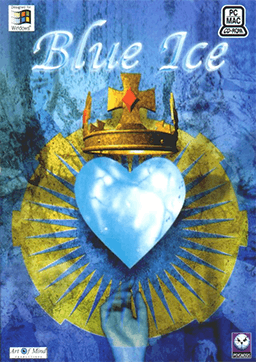Blue Ice (video game)
| Blue Ice | |
|---|---|
 | |
| Developer(s) | Art of Mind Productions |
| Publisher(s) | Psygnosis |
| Platform(s) | Microsoft Windows |
| Release date(s) | 1995 |
| Genre(s) | Adventure |
| Mode(s) | Single player |
Blue Ice is a computer game released in 1995, from Psygnosis. It is similar in design to Myst, with a sequence of screens representing the rooms in a large house, navigated by point and click. The screens are made through what appears to be a blend of grainy photography and bitmap painting. The player completes puzzles by collecting and using items. Some of the puzzles include brewing tea, dissolving gold in vitriol, finding keys, and making blue paint.
Gameplay
Each screen is overlaid with grainy photographs of up to five people, any of whom can be clicked on to read their thoughts. The thoughts contain clues as to what the player is supposed to do in the room. A description of the room is read in orotund style as a voice-over by actor Tom Conti upon first visiting a location, and is also available to read on-screen. There are extra clues in the form of question marks hidden in each screen. Clicking them gives another voice-over that provides a cryptic clue. The first screen includes an additional tool that identifies and describes inventory items. Items to be clicked on often blend in with the background, hence tending toward hunt-the-pixel gameplay. In addition, some sequences of actions have to be repeated over a dozen times.
Most reviewers agree that the interface is fiddly: requiring a right-click to access a horizontal-scrolling sequence of icons, which includes three tools - one to move between locations, one to read thoughts/activate clues and one to pick up or manipulate objects. The same set of icons includes the inventory items, which can grow quite large during the course of the game. It is also possible to navigate between locations by right-clicking and dragging on a widget at the bottom of the screen that shows thumbnails of visited locations, and then left-clicking to select one. Loading and saving features a similar interface, with save slots represented by Greek letters.
Story
The game takes place in a fictional kingdom called Icia, in which millions of laws have been contrived by its succession of rulers. The senseless law-making began with King Edward I, who found that he could blame the loss of his newborn child on the innocent Orseppro and banish her from the kingdom. Ever since, the monarchs of Icia invented laws to cover up their own mistakes and shortcomings. When King Edward DCCXI (711th) dies prematurely, his twelve-year-old son is left with the impossible task of learning all the rules of the kingdom before he comes of age and inherits it. During this kingless period, it is stated that 'time stops'. The player's goal is to teach Edward that the laws are fuelling suffering and unhappiness in the kingdom, including his own. To do this, the player must complete tasks related to five pleasures of life - art, music, food, love and nature - that were otherwise restricted and shackled by laws.
In the king's residence are the servants to Edward - the cook, Daisy Scraggend; her daughter, Pollyanna; and Olly, a farmhand. The final character in the game is Hope - a personification of hope who provides an optimistic outlook.
There are twenty-eight major locations that the player visits. A testament to the surrealism of the game is the ability to enter locations like the pond, the sky, the Sun, a glass of wine and even Daisy Scraggend's mouth. Each location features a looping portion from a piece of jazz, classical or new age music. The particular piece can be identified by clicking the CD icon at the top of the screen. The most-used album for the game is The Future Sound of London's Lifeforms. Other artists/composers used include Paul Schütze, Tchaikovsky, Delibes, Maurice Ravel, Brian and Roger Eno, Blythe and Joustra, Tangerine Dream, David Sylvian and Duke Ellington.
The Ultimate Solution
The game has earned a reputation for being very hard or even impossible to solve, gaining quasi-mythical status and leading many players and reviewers wondering whether there was an ending at all, a doubt which was not completely unfounded.
In fact, even though an author-aided walkthrough to the game exists, which apparently leads to the game's "Ultimate Solution", Blue Ice had the peculiarity of never treating the player any sort of real "ending screen" or even any progress confirmation or feedback.
The purported reason is that a cash-prize competition was originally to be held involving the solution to the game, which explains why a lot of the later puzzles were apparently irrational, intentionally clueless or even incomplete, and why the game didn't actually include any progress indicators, any form of feedback or even a true "ending screen" confirming having reached the final solution or at least being on the right path. The authors' intention was to prevent hacking into a final screen and making illegitimate claims to the proposed prize, so instead players were expected to post a complete progress report. The competition, however, was never held.